Business Report: Sainsbury's - Operations, Finance, and HR Analysis
VerifiedAdded on 2020/07/22
|13
|3727
|115
Report
AI Summary
This report provides a comprehensive analysis of Sainsbury's, a major UK supermarket chain, examining various aspects of its business operations. The report begins with an introduction to the business environment and the importance of adapting to market changes, followed by a discussion on the types of organizations in the public and private sectors, and different organizational structures within businesses, using Sainsbury's as a case study. The report also explores the impact of local, national, and global economic environments on Sainsbury's. Furthermore, the report delves into the importance of accounting for business success, different functions carried out by the HR department, and features of employee legislation. It then interprets the information on a profit and loss account, discusses stages of team development, motivational theories, leadership styles, and the impact of customer service on business success. The report concludes by highlighting the benefits of customer profiling for a business, providing a detailed overview of Sainsbury's business strategies and operational effectiveness.
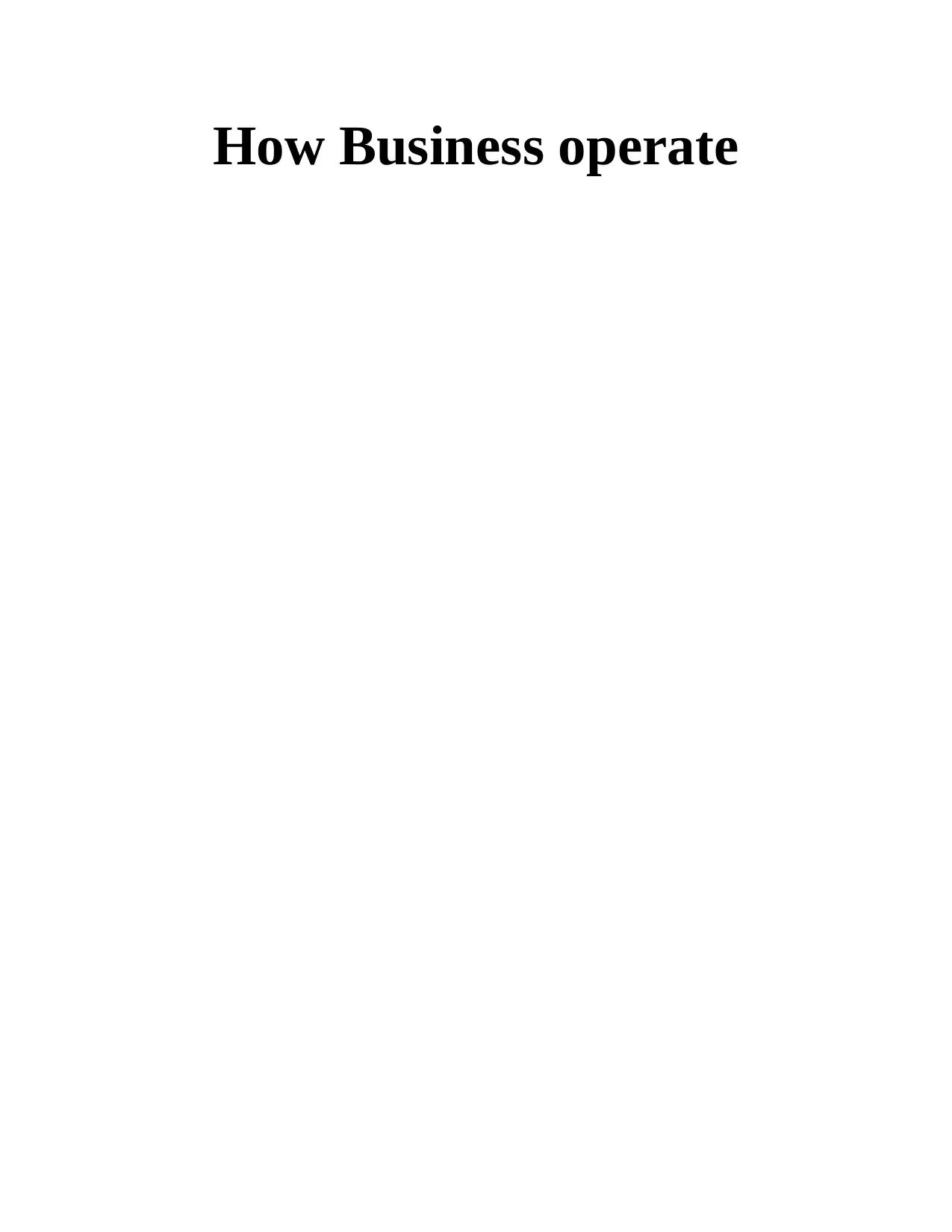
How Business operate
Paraphrase This Document
Need a fresh take? Get an instant paraphrase of this document with our AI Paraphraser
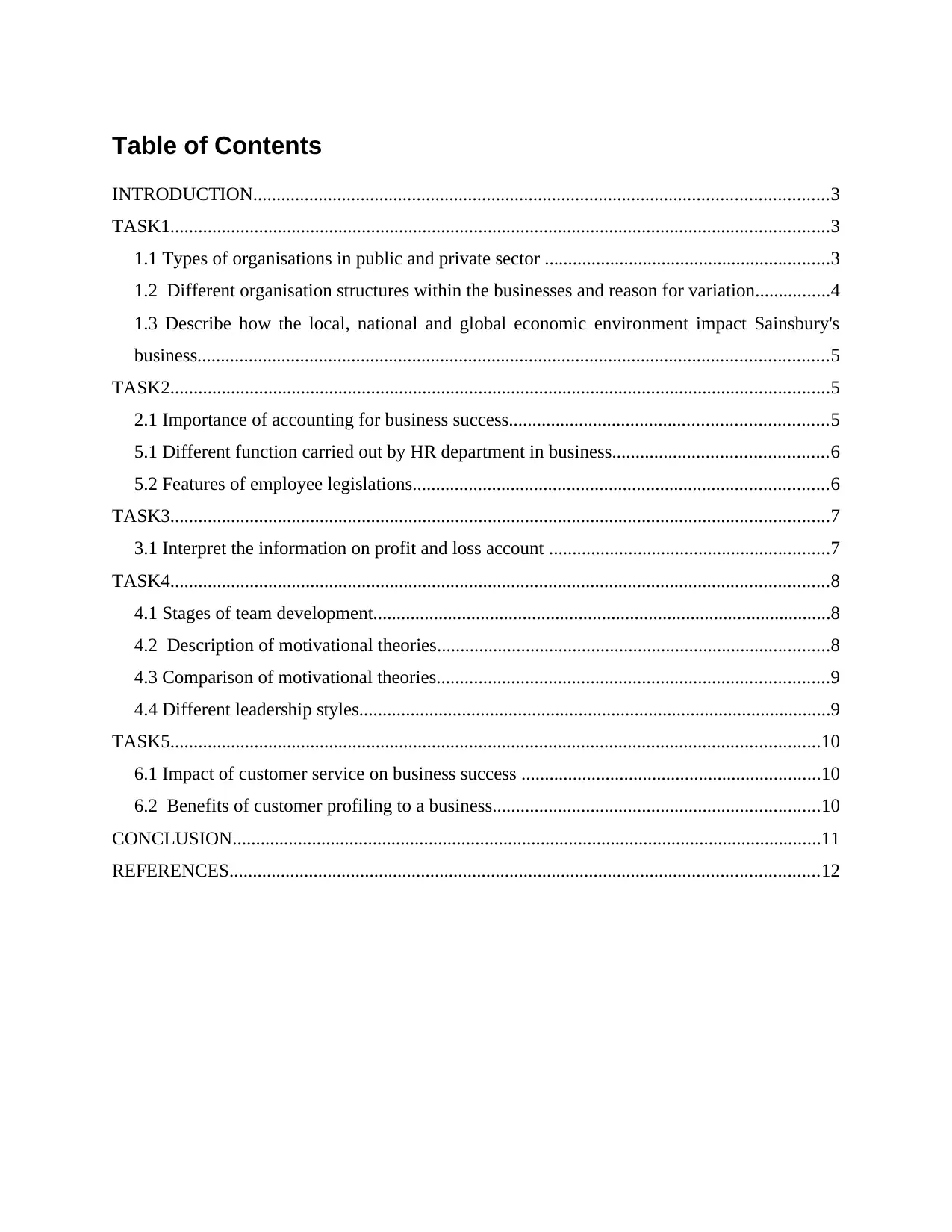
Table of Contents
INTRODUCTION...........................................................................................................................3
TASK1.............................................................................................................................................3
1.1 Types of organisations in public and private sector .............................................................3
1.2 Different organisation structures within the businesses and reason for variation................4
1.3 Describe how the local, national and global economic environment impact Sainsbury's
business.......................................................................................................................................5
TASK2.............................................................................................................................................5
2.1 Importance of accounting for business success....................................................................5
5.1 Different function carried out by HR department in business..............................................6
5.2 Features of employee legislations.........................................................................................6
TASK3.............................................................................................................................................7
3.1 Interpret the information on profit and loss account ............................................................7
TASK4.............................................................................................................................................8
4.1 Stages of team development..................................................................................................8
4.2 Description of motivational theories....................................................................................8
4.3 Comparison of motivational theories....................................................................................9
4.4 Different leadership styles.....................................................................................................9
TASK5...........................................................................................................................................10
6.1 Impact of customer service on business success ................................................................10
6.2 Benefits of customer profiling to a business......................................................................10
CONCLUSION..............................................................................................................................11
REFERENCES..............................................................................................................................12
INTRODUCTION...........................................................................................................................3
TASK1.............................................................................................................................................3
1.1 Types of organisations in public and private sector .............................................................3
1.2 Different organisation structures within the businesses and reason for variation................4
1.3 Describe how the local, national and global economic environment impact Sainsbury's
business.......................................................................................................................................5
TASK2.............................................................................................................................................5
2.1 Importance of accounting for business success....................................................................5
5.1 Different function carried out by HR department in business..............................................6
5.2 Features of employee legislations.........................................................................................6
TASK3.............................................................................................................................................7
3.1 Interpret the information on profit and loss account ............................................................7
TASK4.............................................................................................................................................8
4.1 Stages of team development..................................................................................................8
4.2 Description of motivational theories....................................................................................8
4.3 Comparison of motivational theories....................................................................................9
4.4 Different leadership styles.....................................................................................................9
TASK5...........................................................................................................................................10
6.1 Impact of customer service on business success ................................................................10
6.2 Benefits of customer profiling to a business......................................................................10
CONCLUSION..............................................................................................................................11
REFERENCES..............................................................................................................................12
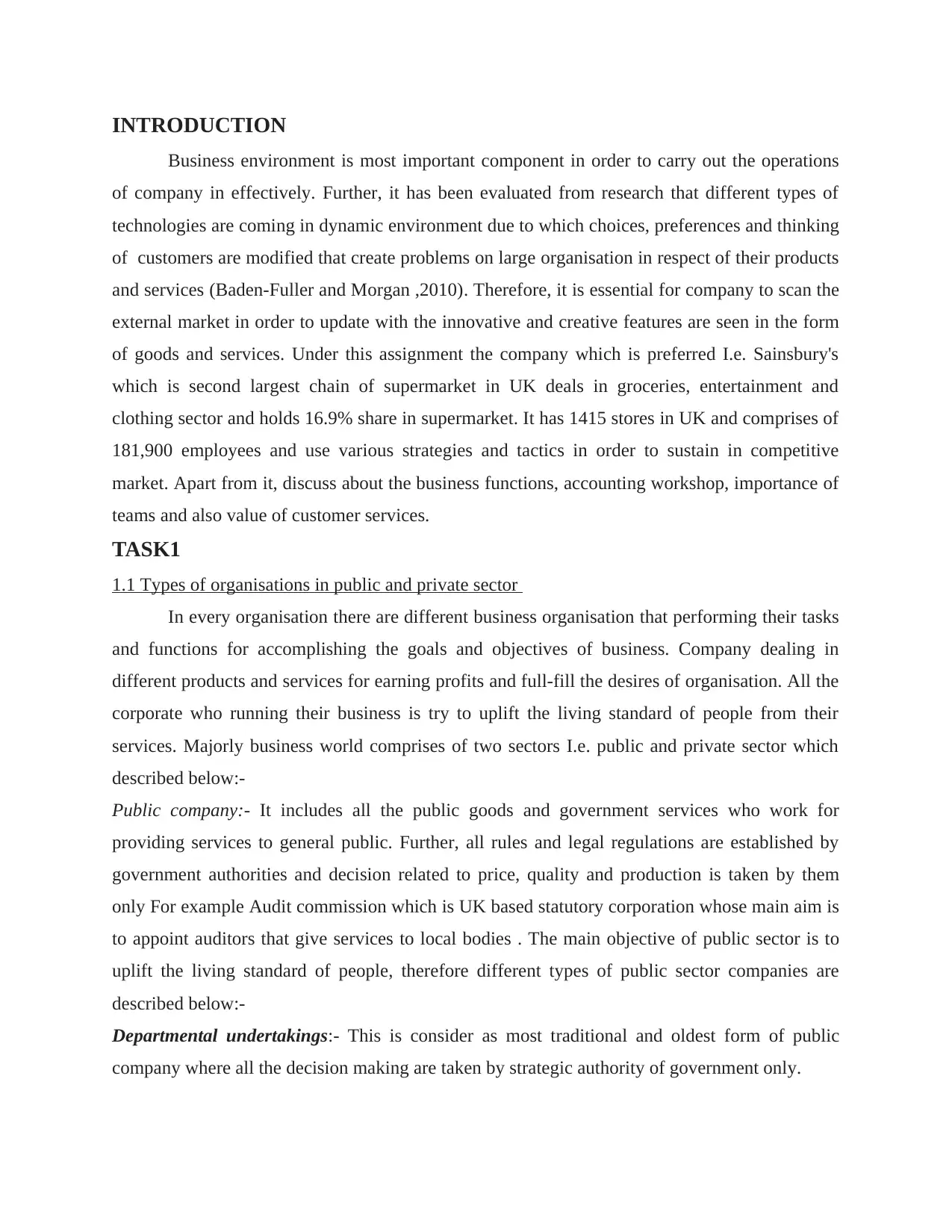
INTRODUCTION
Business environment is most important component in order to carry out the operations
of company in effectively. Further, it has been evaluated from research that different types of
technologies are coming in dynamic environment due to which choices, preferences and thinking
of customers are modified that create problems on large organisation in respect of their products
and services (Baden-Fuller and Morgan ,2010). Therefore, it is essential for company to scan the
external market in order to update with the innovative and creative features are seen in the form
of goods and services. Under this assignment the company which is preferred I.e. Sainsbury's
which is second largest chain of supermarket in UK deals in groceries, entertainment and
clothing sector and holds 16.9% share in supermarket. It has 1415 stores in UK and comprises of
181,900 employees and use various strategies and tactics in order to sustain in competitive
market. Apart from it, discuss about the business functions, accounting workshop, importance of
teams and also value of customer services.
TASK1
1.1 Types of organisations in public and private sector
In every organisation there are different business organisation that performing their tasks
and functions for accomplishing the goals and objectives of business. Company dealing in
different products and services for earning profits and full-fill the desires of organisation. All the
corporate who running their business is try to uplift the living standard of people from their
services. Majorly business world comprises of two sectors I.e. public and private sector which
described below:-
Public company:- It includes all the public goods and government services who work for
providing services to general public. Further, all rules and legal regulations are established by
government authorities and decision related to price, quality and production is taken by them
only For example Audit commission which is UK based statutory corporation whose main aim is
to appoint auditors that give services to local bodies . The main objective of public sector is to
uplift the living standard of people, therefore different types of public sector companies are
described below:-
Departmental undertakings:- This is consider as most traditional and oldest form of public
company where all the decision making are taken by strategic authority of government only.
Business environment is most important component in order to carry out the operations
of company in effectively. Further, it has been evaluated from research that different types of
technologies are coming in dynamic environment due to which choices, preferences and thinking
of customers are modified that create problems on large organisation in respect of their products
and services (Baden-Fuller and Morgan ,2010). Therefore, it is essential for company to scan the
external market in order to update with the innovative and creative features are seen in the form
of goods and services. Under this assignment the company which is preferred I.e. Sainsbury's
which is second largest chain of supermarket in UK deals in groceries, entertainment and
clothing sector and holds 16.9% share in supermarket. It has 1415 stores in UK and comprises of
181,900 employees and use various strategies and tactics in order to sustain in competitive
market. Apart from it, discuss about the business functions, accounting workshop, importance of
teams and also value of customer services.
TASK1
1.1 Types of organisations in public and private sector
In every organisation there are different business organisation that performing their tasks
and functions for accomplishing the goals and objectives of business. Company dealing in
different products and services for earning profits and full-fill the desires of organisation. All the
corporate who running their business is try to uplift the living standard of people from their
services. Majorly business world comprises of two sectors I.e. public and private sector which
described below:-
Public company:- It includes all the public goods and government services who work for
providing services to general public. Further, all rules and legal regulations are established by
government authorities and decision related to price, quality and production is taken by them
only For example Audit commission which is UK based statutory corporation whose main aim is
to appoint auditors that give services to local bodies . The main objective of public sector is to
uplift the living standard of people, therefore different types of public sector companies are
described below:-
Departmental undertakings:- This is consider as most traditional and oldest form of public
company where all the decision making are taken by strategic authority of government only.
⊘ This is a preview!⊘
Do you want full access?
Subscribe today to unlock all pages.

Trusted by 1+ million students worldwide
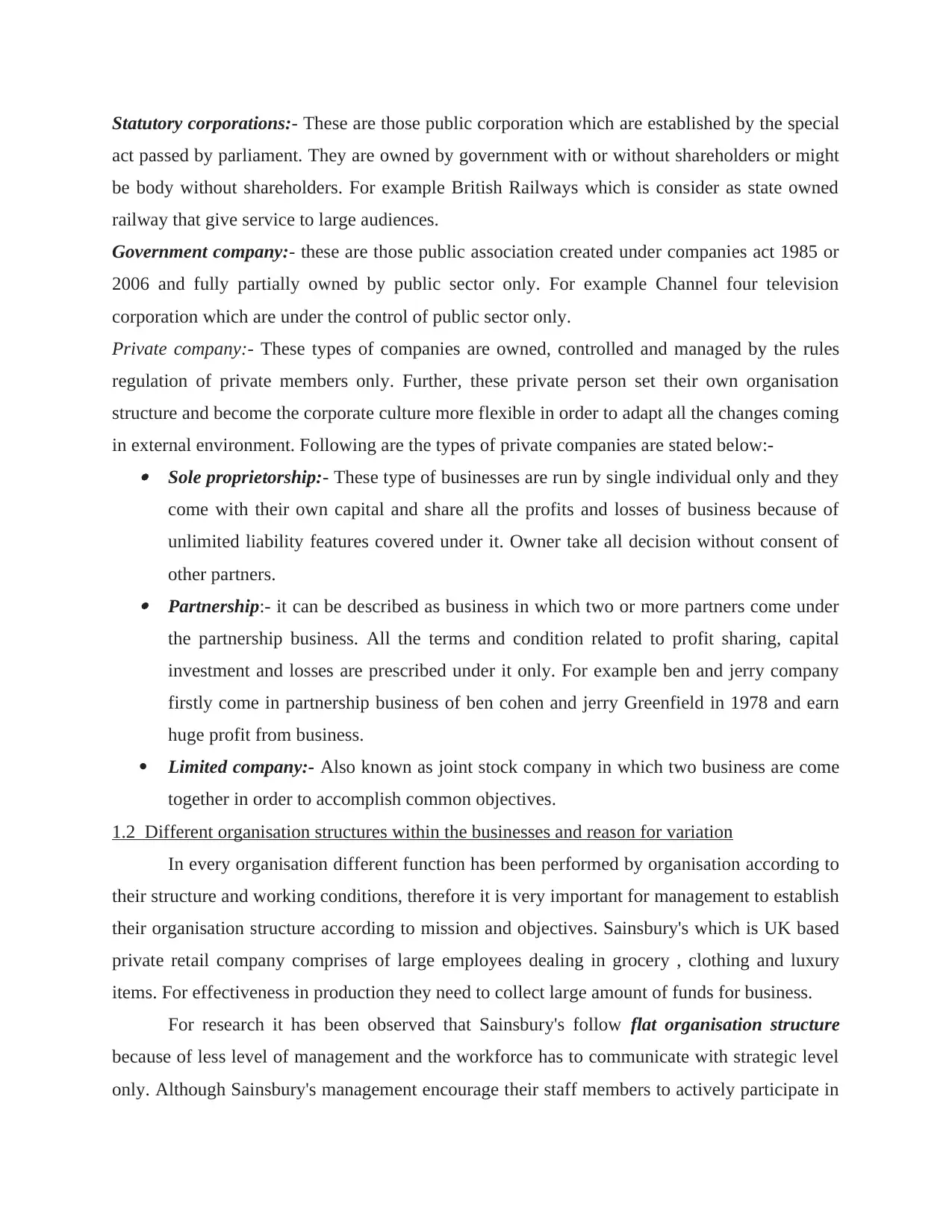
Statutory corporations:- These are those public corporation which are established by the special
act passed by parliament. They are owned by government with or without shareholders or might
be body without shareholders. For example British Railways which is consider as state owned
railway that give service to large audiences.
Government company:- these are those public association created under companies act 1985 or
2006 and fully partially owned by public sector only. For example Channel four television
corporation which are under the control of public sector only.
Private company:- These types of companies are owned, controlled and managed by the rules
regulation of private members only. Further, these private person set their own organisation
structure and become the corporate culture more flexible in order to adapt all the changes coming
in external environment. Following are the types of private companies are stated below:- Sole proprietorship:- These type of businesses are run by single individual only and they
come with their own capital and share all the profits and losses of business because of
unlimited liability features covered under it. Owner take all decision without consent of
other partners. Partnership:- it can be described as business in which two or more partners come under
the partnership business. All the terms and condition related to profit sharing, capital
investment and losses are prescribed under it only. For example ben and jerry company
firstly come in partnership business of ben cohen and jerry Greenfield in 1978 and earn
huge profit from business.
Limited company:- Also known as joint stock company in which two business are come
together in order to accomplish common objectives.
1.2 Different organisation structures within the businesses and reason for variation
In every organisation different function has been performed by organisation according to
their structure and working conditions, therefore it is very important for management to establish
their organisation structure according to mission and objectives. Sainsbury's which is UK based
private retail company comprises of large employees dealing in grocery , clothing and luxury
items. For effectiveness in production they need to collect large amount of funds for business.
For research it has been observed that Sainsbury's follow flat organisation structure
because of less level of management and the workforce has to communicate with strategic level
only. Although Sainsbury's management encourage their staff members to actively participate in
act passed by parliament. They are owned by government with or without shareholders or might
be body without shareholders. For example British Railways which is consider as state owned
railway that give service to large audiences.
Government company:- these are those public association created under companies act 1985 or
2006 and fully partially owned by public sector only. For example Channel four television
corporation which are under the control of public sector only.
Private company:- These types of companies are owned, controlled and managed by the rules
regulation of private members only. Further, these private person set their own organisation
structure and become the corporate culture more flexible in order to adapt all the changes coming
in external environment. Following are the types of private companies are stated below:- Sole proprietorship:- These type of businesses are run by single individual only and they
come with their own capital and share all the profits and losses of business because of
unlimited liability features covered under it. Owner take all decision without consent of
other partners. Partnership:- it can be described as business in which two or more partners come under
the partnership business. All the terms and condition related to profit sharing, capital
investment and losses are prescribed under it only. For example ben and jerry company
firstly come in partnership business of ben cohen and jerry Greenfield in 1978 and earn
huge profit from business.
Limited company:- Also known as joint stock company in which two business are come
together in order to accomplish common objectives.
1.2 Different organisation structures within the businesses and reason for variation
In every organisation different function has been performed by organisation according to
their structure and working conditions, therefore it is very important for management to establish
their organisation structure according to mission and objectives. Sainsbury's which is UK based
private retail company comprises of large employees dealing in grocery , clothing and luxury
items. For effectiveness in production they need to collect large amount of funds for business.
For research it has been observed that Sainsbury's follow flat organisation structure
because of less level of management and the workforce has to communicate with strategic level
only. Although Sainsbury's management encourage their staff members to actively participate in
Paraphrase This Document
Need a fresh take? Get an instant paraphrase of this document with our AI Paraphraser
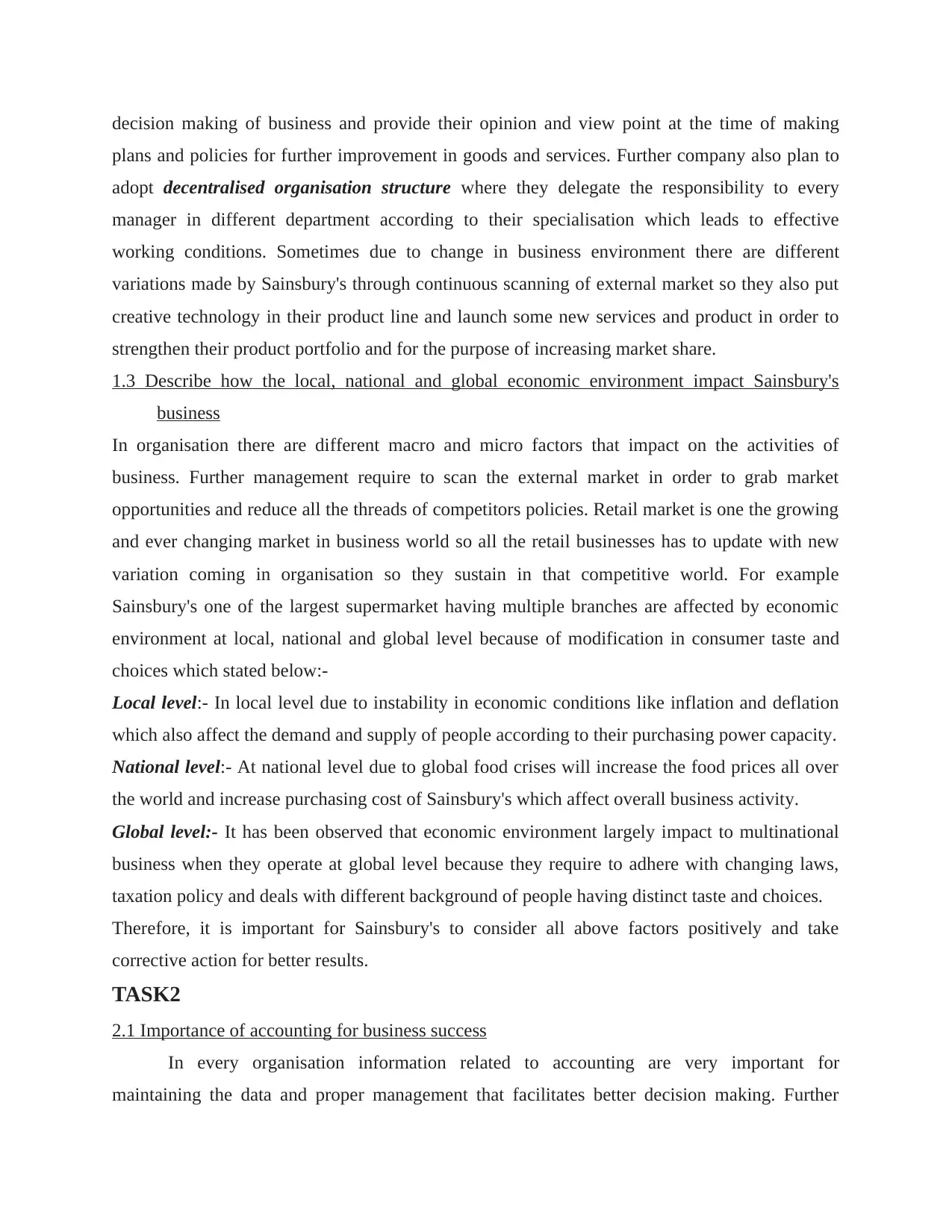
decision making of business and provide their opinion and view point at the time of making
plans and policies for further improvement in goods and services. Further company also plan to
adopt decentralised organisation structure where they delegate the responsibility to every
manager in different department according to their specialisation which leads to effective
working conditions. Sometimes due to change in business environment there are different
variations made by Sainsbury's through continuous scanning of external market so they also put
creative technology in their product line and launch some new services and product in order to
strengthen their product portfolio and for the purpose of increasing market share.
1.3 Describe how the local, national and global economic environment impact Sainsbury's
business
In organisation there are different macro and micro factors that impact on the activities of
business. Further management require to scan the external market in order to grab market
opportunities and reduce all the threads of competitors policies. Retail market is one the growing
and ever changing market in business world so all the retail businesses has to update with new
variation coming in organisation so they sustain in that competitive world. For example
Sainsbury's one of the largest supermarket having multiple branches are affected by economic
environment at local, national and global level because of modification in consumer taste and
choices which stated below:-
Local level:- In local level due to instability in economic conditions like inflation and deflation
which also affect the demand and supply of people according to their purchasing power capacity.
National level:- At national level due to global food crises will increase the food prices all over
the world and increase purchasing cost of Sainsbury's which affect overall business activity.
Global level:- It has been observed that economic environment largely impact to multinational
business when they operate at global level because they require to adhere with changing laws,
taxation policy and deals with different background of people having distinct taste and choices.
Therefore, it is important for Sainsbury's to consider all above factors positively and take
corrective action for better results.
TASK2
2.1 Importance of accounting for business success
In every organisation information related to accounting are very important for
maintaining the data and proper management that facilitates better decision making. Further
plans and policies for further improvement in goods and services. Further company also plan to
adopt decentralised organisation structure where they delegate the responsibility to every
manager in different department according to their specialisation which leads to effective
working conditions. Sometimes due to change in business environment there are different
variations made by Sainsbury's through continuous scanning of external market so they also put
creative technology in their product line and launch some new services and product in order to
strengthen their product portfolio and for the purpose of increasing market share.
1.3 Describe how the local, national and global economic environment impact Sainsbury's
business
In organisation there are different macro and micro factors that impact on the activities of
business. Further management require to scan the external market in order to grab market
opportunities and reduce all the threads of competitors policies. Retail market is one the growing
and ever changing market in business world so all the retail businesses has to update with new
variation coming in organisation so they sustain in that competitive world. For example
Sainsbury's one of the largest supermarket having multiple branches are affected by economic
environment at local, national and global level because of modification in consumer taste and
choices which stated below:-
Local level:- In local level due to instability in economic conditions like inflation and deflation
which also affect the demand and supply of people according to their purchasing power capacity.
National level:- At national level due to global food crises will increase the food prices all over
the world and increase purchasing cost of Sainsbury's which affect overall business activity.
Global level:- It has been observed that economic environment largely impact to multinational
business when they operate at global level because they require to adhere with changing laws,
taxation policy and deals with different background of people having distinct taste and choices.
Therefore, it is important for Sainsbury's to consider all above factors positively and take
corrective action for better results.
TASK2
2.1 Importance of accounting for business success
In every organisation information related to accounting are very important for
maintaining the data and proper management that facilitates better decision making. Further
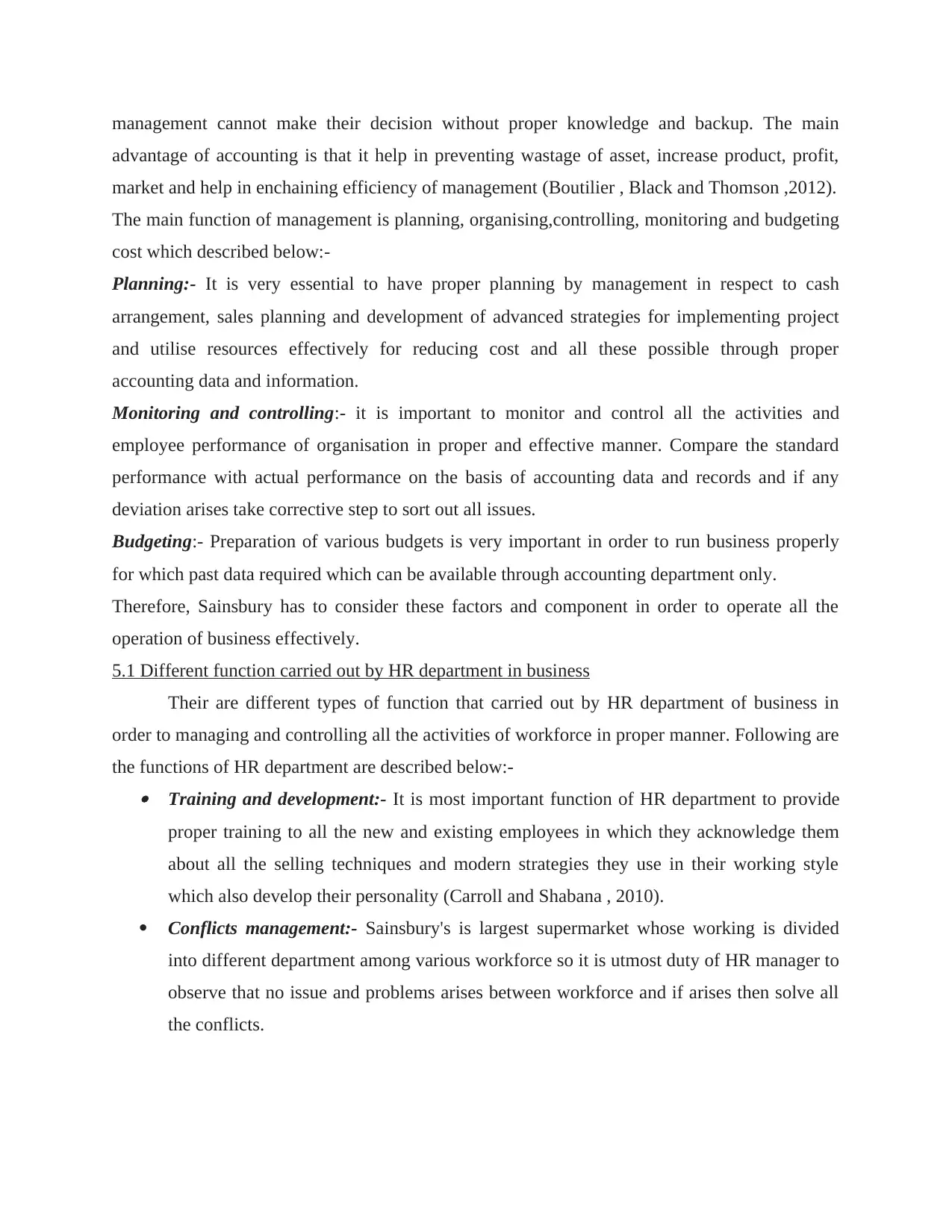
management cannot make their decision without proper knowledge and backup. The main
advantage of accounting is that it help in preventing wastage of asset, increase product, profit,
market and help in enchaining efficiency of management (Boutilier , Black and Thomson ,2012).
The main function of management is planning, organising,controlling, monitoring and budgeting
cost which described below:-
Planning:- It is very essential to have proper planning by management in respect to cash
arrangement, sales planning and development of advanced strategies for implementing project
and utilise resources effectively for reducing cost and all these possible through proper
accounting data and information.
Monitoring and controlling:- it is important to monitor and control all the activities and
employee performance of organisation in proper and effective manner. Compare the standard
performance with actual performance on the basis of accounting data and records and if any
deviation arises take corrective step to sort out all issues.
Budgeting:- Preparation of various budgets is very important in order to run business properly
for which past data required which can be available through accounting department only.
Therefore, Sainsbury has to consider these factors and component in order to operate all the
operation of business effectively.
5.1 Different function carried out by HR department in business
Their are different types of function that carried out by HR department of business in
order to managing and controlling all the activities of workforce in proper manner. Following are
the functions of HR department are described below:- Training and development:- It is most important function of HR department to provide
proper training to all the new and existing employees in which they acknowledge them
about all the selling techniques and modern strategies they use in their working style
which also develop their personality (Carroll and Shabana , 2010).
Conflicts management:- Sainsbury's is largest supermarket whose working is divided
into different department among various workforce so it is utmost duty of HR manager to
observe that no issue and problems arises between workforce and if arises then solve all
the conflicts.
advantage of accounting is that it help in preventing wastage of asset, increase product, profit,
market and help in enchaining efficiency of management (Boutilier , Black and Thomson ,2012).
The main function of management is planning, organising,controlling, monitoring and budgeting
cost which described below:-
Planning:- It is very essential to have proper planning by management in respect to cash
arrangement, sales planning and development of advanced strategies for implementing project
and utilise resources effectively for reducing cost and all these possible through proper
accounting data and information.
Monitoring and controlling:- it is important to monitor and control all the activities and
employee performance of organisation in proper and effective manner. Compare the standard
performance with actual performance on the basis of accounting data and records and if any
deviation arises take corrective step to sort out all issues.
Budgeting:- Preparation of various budgets is very important in order to run business properly
for which past data required which can be available through accounting department only.
Therefore, Sainsbury has to consider these factors and component in order to operate all the
operation of business effectively.
5.1 Different function carried out by HR department in business
Their are different types of function that carried out by HR department of business in
order to managing and controlling all the activities of workforce in proper manner. Following are
the functions of HR department are described below:- Training and development:- It is most important function of HR department to provide
proper training to all the new and existing employees in which they acknowledge them
about all the selling techniques and modern strategies they use in their working style
which also develop their personality (Carroll and Shabana , 2010).
Conflicts management:- Sainsbury's is largest supermarket whose working is divided
into different department among various workforce so it is utmost duty of HR manager to
observe that no issue and problems arises between workforce and if arises then solve all
the conflicts.
⊘ This is a preview!⊘
Do you want full access?
Subscribe today to unlock all pages.

Trusted by 1+ million students worldwide
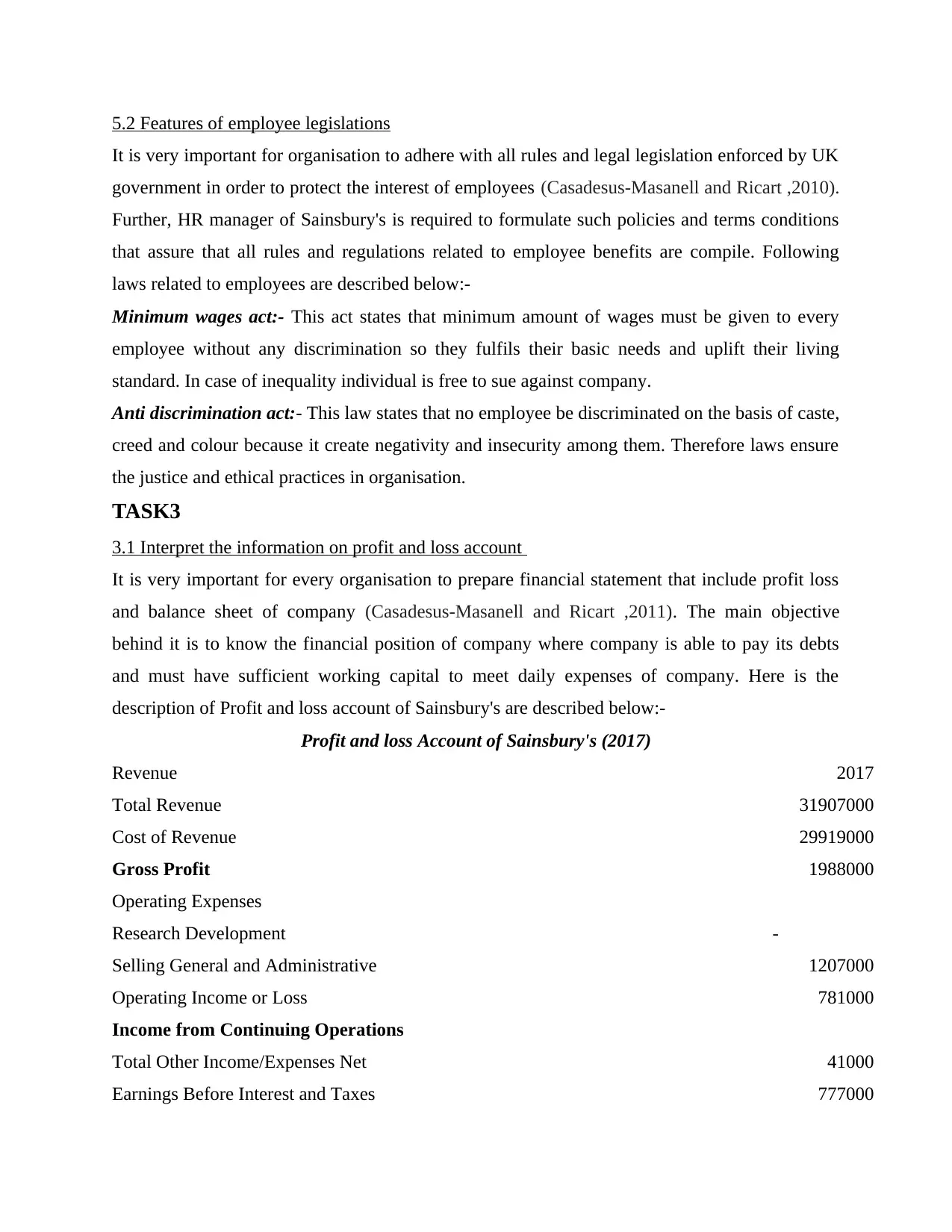
5.2 Features of employee legislations
It is very important for organisation to adhere with all rules and legal legislation enforced by UK
government in order to protect the interest of employees (Casadesus-Masanell and Ricart ,2010).
Further, HR manager of Sainsbury's is required to formulate such policies and terms conditions
that assure that all rules and regulations related to employee benefits are compile. Following
laws related to employees are described below:-
Minimum wages act:- This act states that minimum amount of wages must be given to every
employee without any discrimination so they fulfils their basic needs and uplift their living
standard. In case of inequality individual is free to sue against company.
Anti discrimination act:- This law states that no employee be discriminated on the basis of caste,
creed and colour because it create negativity and insecurity among them. Therefore laws ensure
the justice and ethical practices in organisation.
TASK3
3.1 Interpret the information on profit and loss account
It is very important for every organisation to prepare financial statement that include profit loss
and balance sheet of company (Casadesus-Masanell and Ricart ,2011). The main objective
behind it is to know the financial position of company where company is able to pay its debts
and must have sufficient working capital to meet daily expenses of company. Here is the
description of Profit and loss account of Sainsbury's are described below:-
Profit and loss Account of Sainsbury's (2017)
Revenue 2017
Total Revenue 31907000
Cost of Revenue 29919000
Gross Profit 1988000
Operating Expenses
Research Development -
Selling General and Administrative 1207000
Operating Income or Loss 781000
Income from Continuing Operations
Total Other Income/Expenses Net 41000
Earnings Before Interest and Taxes 777000
It is very important for organisation to adhere with all rules and legal legislation enforced by UK
government in order to protect the interest of employees (Casadesus-Masanell and Ricart ,2010).
Further, HR manager of Sainsbury's is required to formulate such policies and terms conditions
that assure that all rules and regulations related to employee benefits are compile. Following
laws related to employees are described below:-
Minimum wages act:- This act states that minimum amount of wages must be given to every
employee without any discrimination so they fulfils their basic needs and uplift their living
standard. In case of inequality individual is free to sue against company.
Anti discrimination act:- This law states that no employee be discriminated on the basis of caste,
creed and colour because it create negativity and insecurity among them. Therefore laws ensure
the justice and ethical practices in organisation.
TASK3
3.1 Interpret the information on profit and loss account
It is very important for every organisation to prepare financial statement that include profit loss
and balance sheet of company (Casadesus-Masanell and Ricart ,2011). The main objective
behind it is to know the financial position of company where company is able to pay its debts
and must have sufficient working capital to meet daily expenses of company. Here is the
description of Profit and loss account of Sainsbury's are described below:-
Profit and loss Account of Sainsbury's (2017)
Revenue 2017
Total Revenue 31907000
Cost of Revenue 29919000
Gross Profit 1988000
Operating Expenses
Research Development -
Selling General and Administrative 1207000
Operating Income or Loss 781000
Income from Continuing Operations
Total Other Income/Expenses Net 41000
Earnings Before Interest and Taxes 777000
Paraphrase This Document
Need a fresh take? Get an instant paraphrase of this document with our AI Paraphraser
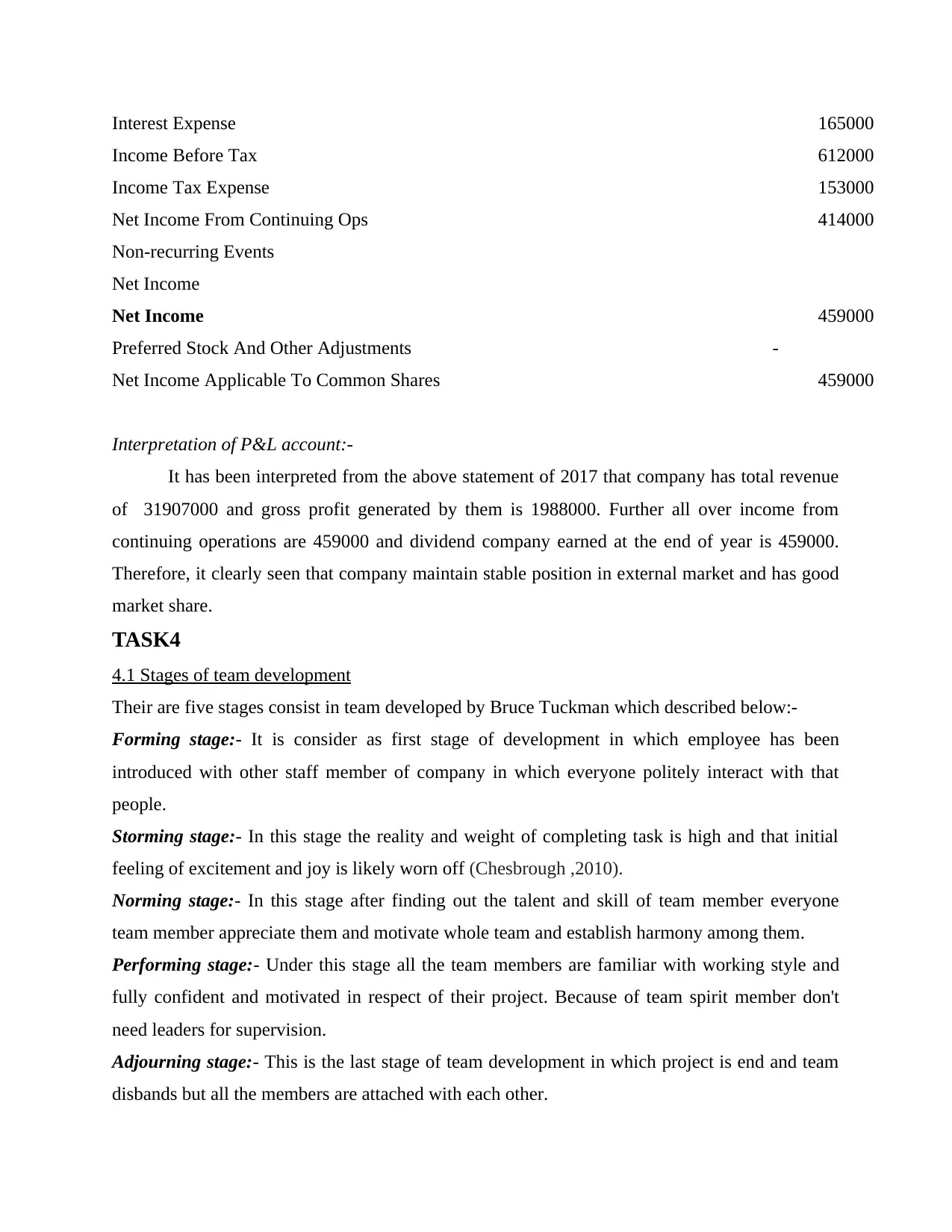
Interest Expense 165000
Income Before Tax 612000
Income Tax Expense 153000
Net Income From Continuing Ops 414000
Non-recurring Events
Net Income
Net Income 459000
Preferred Stock And Other Adjustments -
Net Income Applicable To Common Shares 459000
Interpretation of P&L account:-
It has been interpreted from the above statement of 2017 that company has total revenue
of 31907000 and gross profit generated by them is 1988000. Further all over income from
continuing operations are 459000 and dividend company earned at the end of year is 459000.
Therefore, it clearly seen that company maintain stable position in external market and has good
market share.
TASK4
4.1 Stages of team development
Their are five stages consist in team developed by Bruce Tuckman which described below:-
Forming stage:- It is consider as first stage of development in which employee has been
introduced with other staff member of company in which everyone politely interact with that
people.
Storming stage:- In this stage the reality and weight of completing task is high and that initial
feeling of excitement and joy is likely worn off (Chesbrough ,2010).
Norming stage:- In this stage after finding out the talent and skill of team member everyone
team member appreciate them and motivate whole team and establish harmony among them.
Performing stage:- Under this stage all the team members are familiar with working style and
fully confident and motivated in respect of their project. Because of team spirit member don't
need leaders for supervision.
Adjourning stage:- This is the last stage of team development in which project is end and team
disbands but all the members are attached with each other.
Income Before Tax 612000
Income Tax Expense 153000
Net Income From Continuing Ops 414000
Non-recurring Events
Net Income
Net Income 459000
Preferred Stock And Other Adjustments -
Net Income Applicable To Common Shares 459000
Interpretation of P&L account:-
It has been interpreted from the above statement of 2017 that company has total revenue
of 31907000 and gross profit generated by them is 1988000. Further all over income from
continuing operations are 459000 and dividend company earned at the end of year is 459000.
Therefore, it clearly seen that company maintain stable position in external market and has good
market share.
TASK4
4.1 Stages of team development
Their are five stages consist in team developed by Bruce Tuckman which described below:-
Forming stage:- It is consider as first stage of development in which employee has been
introduced with other staff member of company in which everyone politely interact with that
people.
Storming stage:- In this stage the reality and weight of completing task is high and that initial
feeling of excitement and joy is likely worn off (Chesbrough ,2010).
Norming stage:- In this stage after finding out the talent and skill of team member everyone
team member appreciate them and motivate whole team and establish harmony among them.
Performing stage:- Under this stage all the team members are familiar with working style and
fully confident and motivated in respect of their project. Because of team spirit member don't
need leaders for supervision.
Adjourning stage:- This is the last stage of team development in which project is end and team
disbands but all the members are attached with each other.
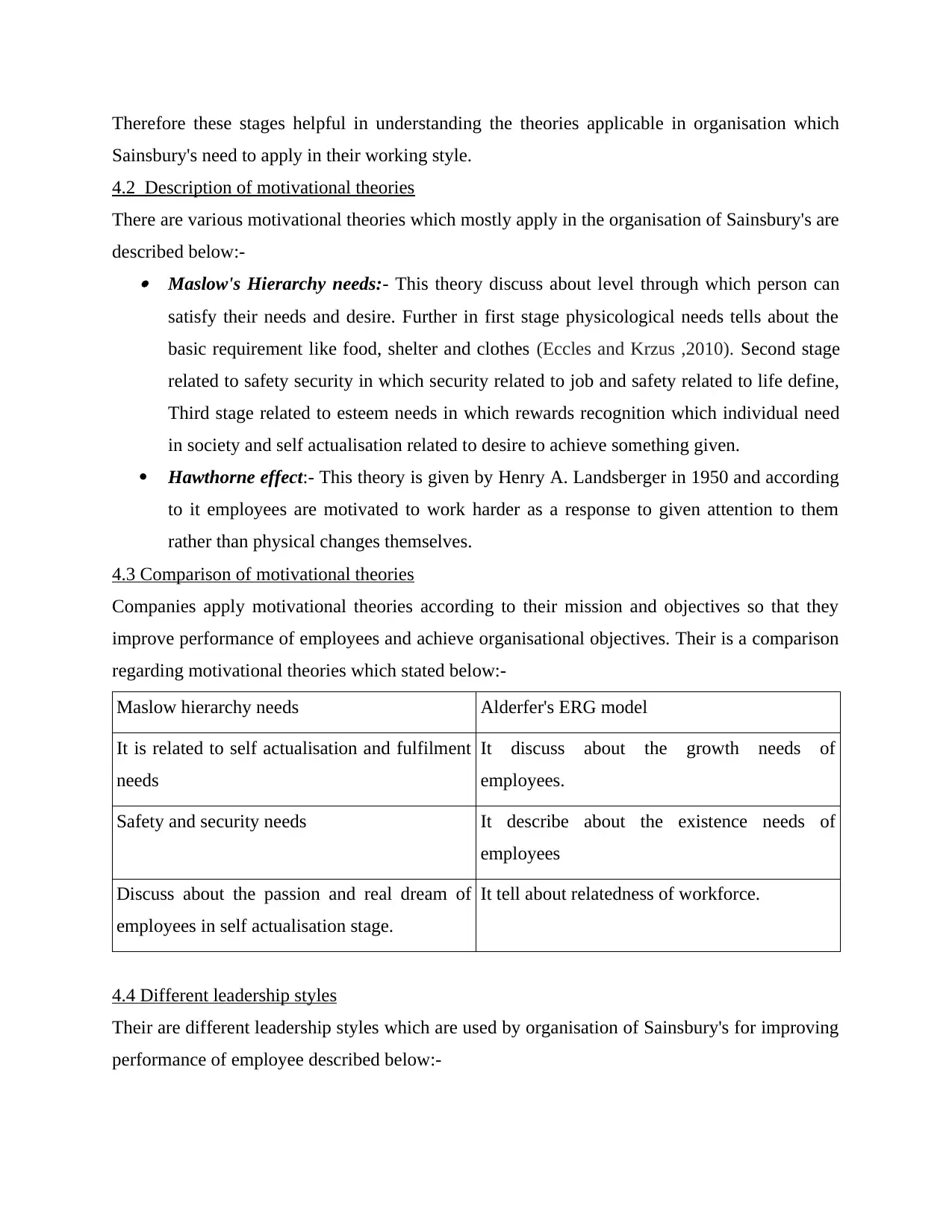
Therefore these stages helpful in understanding the theories applicable in organisation which
Sainsbury's need to apply in their working style.
4.2 Description of motivational theories
There are various motivational theories which mostly apply in the organisation of Sainsbury's are
described below:- Maslow's Hierarchy needs:- This theory discuss about level through which person can
satisfy their needs and desire. Further in first stage physicological needs tells about the
basic requirement like food, shelter and clothes (Eccles and Krzus ,2010). Second stage
related to safety security in which security related to job and safety related to life define,
Third stage related to esteem needs in which rewards recognition which individual need
in society and self actualisation related to desire to achieve something given.
Hawthorne effect:- This theory is given by Henry A. Landsberger in 1950 and according
to it employees are motivated to work harder as a response to given attention to them
rather than physical changes themselves.
4.3 Comparison of motivational theories
Companies apply motivational theories according to their mission and objectives so that they
improve performance of employees and achieve organisational objectives. Their is a comparison
regarding motivational theories which stated below:-
Maslow hierarchy needs Alderfer's ERG model
It is related to self actualisation and fulfilment
needs
It discuss about the growth needs of
employees.
Safety and security needs It describe about the existence needs of
employees
Discuss about the passion and real dream of
employees in self actualisation stage.
It tell about relatedness of workforce.
4.4 Different leadership styles
Their are different leadership styles which are used by organisation of Sainsbury's for improving
performance of employee described below:-
Sainsbury's need to apply in their working style.
4.2 Description of motivational theories
There are various motivational theories which mostly apply in the organisation of Sainsbury's are
described below:- Maslow's Hierarchy needs:- This theory discuss about level through which person can
satisfy their needs and desire. Further in first stage physicological needs tells about the
basic requirement like food, shelter and clothes (Eccles and Krzus ,2010). Second stage
related to safety security in which security related to job and safety related to life define,
Third stage related to esteem needs in which rewards recognition which individual need
in society and self actualisation related to desire to achieve something given.
Hawthorne effect:- This theory is given by Henry A. Landsberger in 1950 and according
to it employees are motivated to work harder as a response to given attention to them
rather than physical changes themselves.
4.3 Comparison of motivational theories
Companies apply motivational theories according to their mission and objectives so that they
improve performance of employees and achieve organisational objectives. Their is a comparison
regarding motivational theories which stated below:-
Maslow hierarchy needs Alderfer's ERG model
It is related to self actualisation and fulfilment
needs
It discuss about the growth needs of
employees.
Safety and security needs It describe about the existence needs of
employees
Discuss about the passion and real dream of
employees in self actualisation stage.
It tell about relatedness of workforce.
4.4 Different leadership styles
Their are different leadership styles which are used by organisation of Sainsbury's for improving
performance of employee described below:-
⊘ This is a preview!⊘
Do you want full access?
Subscribe today to unlock all pages.

Trusted by 1+ million students worldwide
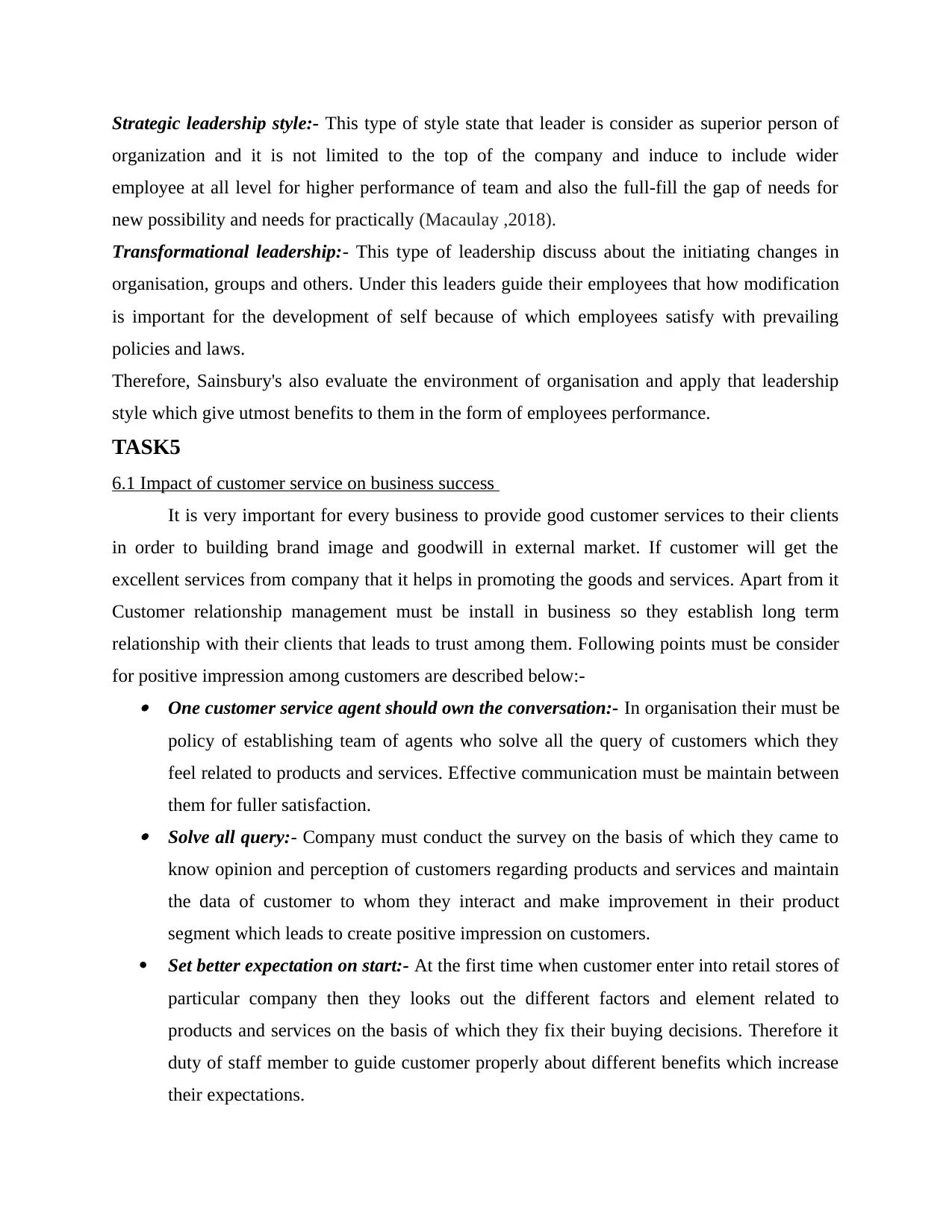
Strategic leadership style:- This type of style state that leader is consider as superior person of
organization and it is not limited to the top of the company and induce to include wider
employee at all level for higher performance of team and also the full-fill the gap of needs for
new possibility and needs for practically (Macaulay ,2018).
Transformational leadership:- This type of leadership discuss about the initiating changes in
organisation, groups and others. Under this leaders guide their employees that how modification
is important for the development of self because of which employees satisfy with prevailing
policies and laws.
Therefore, Sainsbury's also evaluate the environment of organisation and apply that leadership
style which give utmost benefits to them in the form of employees performance.
TASK5
6.1 Impact of customer service on business success
It is very important for every business to provide good customer services to their clients
in order to building brand image and goodwill in external market. If customer will get the
excellent services from company that it helps in promoting the goods and services. Apart from it
Customer relationship management must be install in business so they establish long term
relationship with their clients that leads to trust among them. Following points must be consider
for positive impression among customers are described below:- One customer service agent should own the conversation:- In organisation their must be
policy of establishing team of agents who solve all the query of customers which they
feel related to products and services. Effective communication must be maintain between
them for fuller satisfaction. Solve all query:- Company must conduct the survey on the basis of which they came to
know opinion and perception of customers regarding products and services and maintain
the data of customer to whom they interact and make improvement in their product
segment which leads to create positive impression on customers.
Set better expectation on start:- At the first time when customer enter into retail stores of
particular company then they looks out the different factors and element related to
products and services on the basis of which they fix their buying decisions. Therefore it
duty of staff member to guide customer properly about different benefits which increase
their expectations.
organization and it is not limited to the top of the company and induce to include wider
employee at all level for higher performance of team and also the full-fill the gap of needs for
new possibility and needs for practically (Macaulay ,2018).
Transformational leadership:- This type of leadership discuss about the initiating changes in
organisation, groups and others. Under this leaders guide their employees that how modification
is important for the development of self because of which employees satisfy with prevailing
policies and laws.
Therefore, Sainsbury's also evaluate the environment of organisation and apply that leadership
style which give utmost benefits to them in the form of employees performance.
TASK5
6.1 Impact of customer service on business success
It is very important for every business to provide good customer services to their clients
in order to building brand image and goodwill in external market. If customer will get the
excellent services from company that it helps in promoting the goods and services. Apart from it
Customer relationship management must be install in business so they establish long term
relationship with their clients that leads to trust among them. Following points must be consider
for positive impression among customers are described below:- One customer service agent should own the conversation:- In organisation their must be
policy of establishing team of agents who solve all the query of customers which they
feel related to products and services. Effective communication must be maintain between
them for fuller satisfaction. Solve all query:- Company must conduct the survey on the basis of which they came to
know opinion and perception of customers regarding products and services and maintain
the data of customer to whom they interact and make improvement in their product
segment which leads to create positive impression on customers.
Set better expectation on start:- At the first time when customer enter into retail stores of
particular company then they looks out the different factors and element related to
products and services on the basis of which they fix their buying decisions. Therefore it
duty of staff member to guide customer properly about different benefits which increase
their expectations.
Paraphrase This Document
Need a fresh take? Get an instant paraphrase of this document with our AI Paraphraser
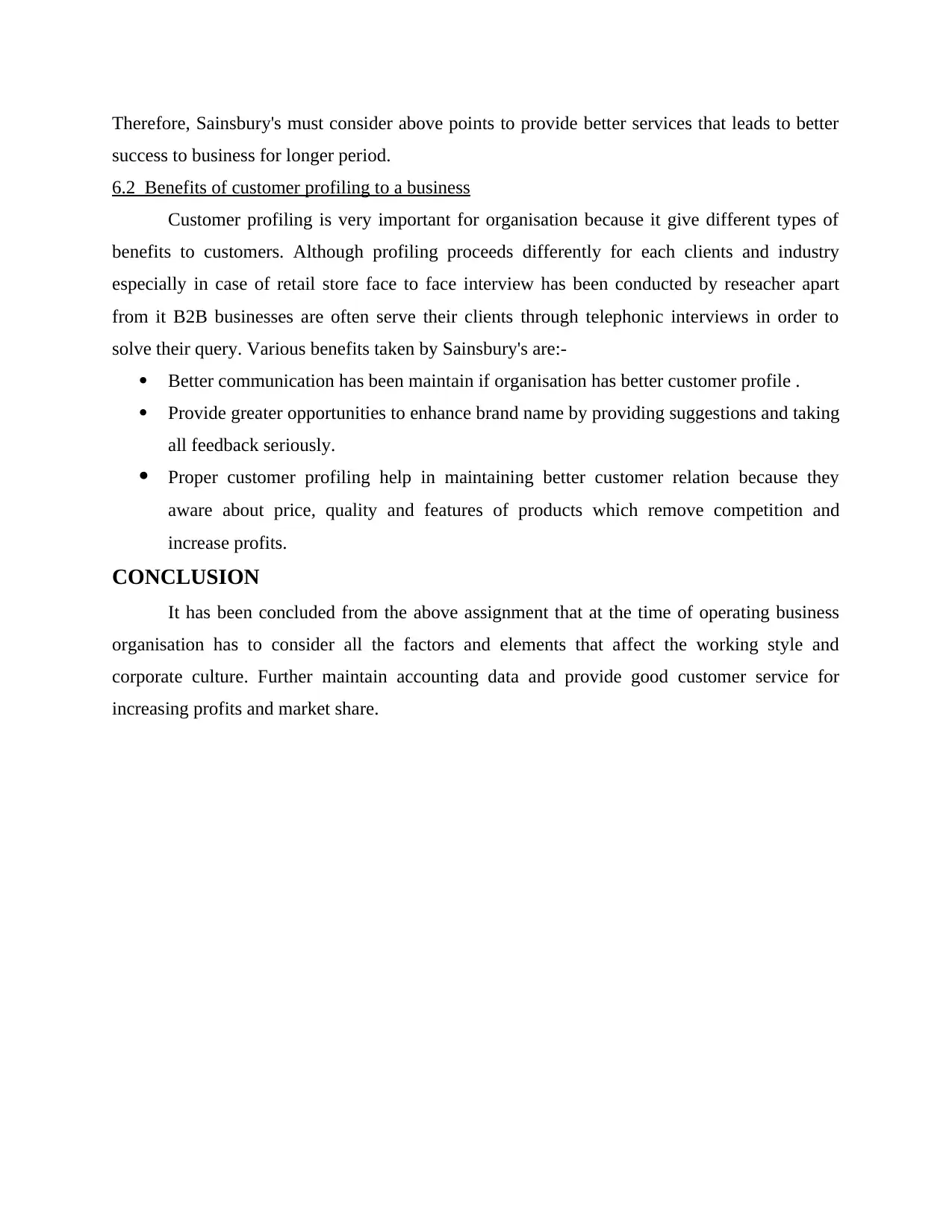
Therefore, Sainsbury's must consider above points to provide better services that leads to better
success to business for longer period.
6.2 Benefits of customer profiling to a business
Customer profiling is very important for organisation because it give different types of
benefits to customers. Although profiling proceeds differently for each clients and industry
especially in case of retail store face to face interview has been conducted by reseacher apart
from it B2B businesses are often serve their clients through telephonic interviews in order to
solve their query. Various benefits taken by Sainsbury's are:-
Better communication has been maintain if organisation has better customer profile .
Provide greater opportunities to enhance brand name by providing suggestions and taking
all feedback seriously.
Proper customer profiling help in maintaining better customer relation because they
aware about price, quality and features of products which remove competition and
increase profits.
CONCLUSION
It has been concluded from the above assignment that at the time of operating business
organisation has to consider all the factors and elements that affect the working style and
corporate culture. Further maintain accounting data and provide good customer service for
increasing profits and market share.
success to business for longer period.
6.2 Benefits of customer profiling to a business
Customer profiling is very important for organisation because it give different types of
benefits to customers. Although profiling proceeds differently for each clients and industry
especially in case of retail store face to face interview has been conducted by reseacher apart
from it B2B businesses are often serve their clients through telephonic interviews in order to
solve their query. Various benefits taken by Sainsbury's are:-
Better communication has been maintain if organisation has better customer profile .
Provide greater opportunities to enhance brand name by providing suggestions and taking
all feedback seriously.
Proper customer profiling help in maintaining better customer relation because they
aware about price, quality and features of products which remove competition and
increase profits.
CONCLUSION
It has been concluded from the above assignment that at the time of operating business
organisation has to consider all the factors and elements that affect the working style and
corporate culture. Further maintain accounting data and provide good customer service for
increasing profits and market share.
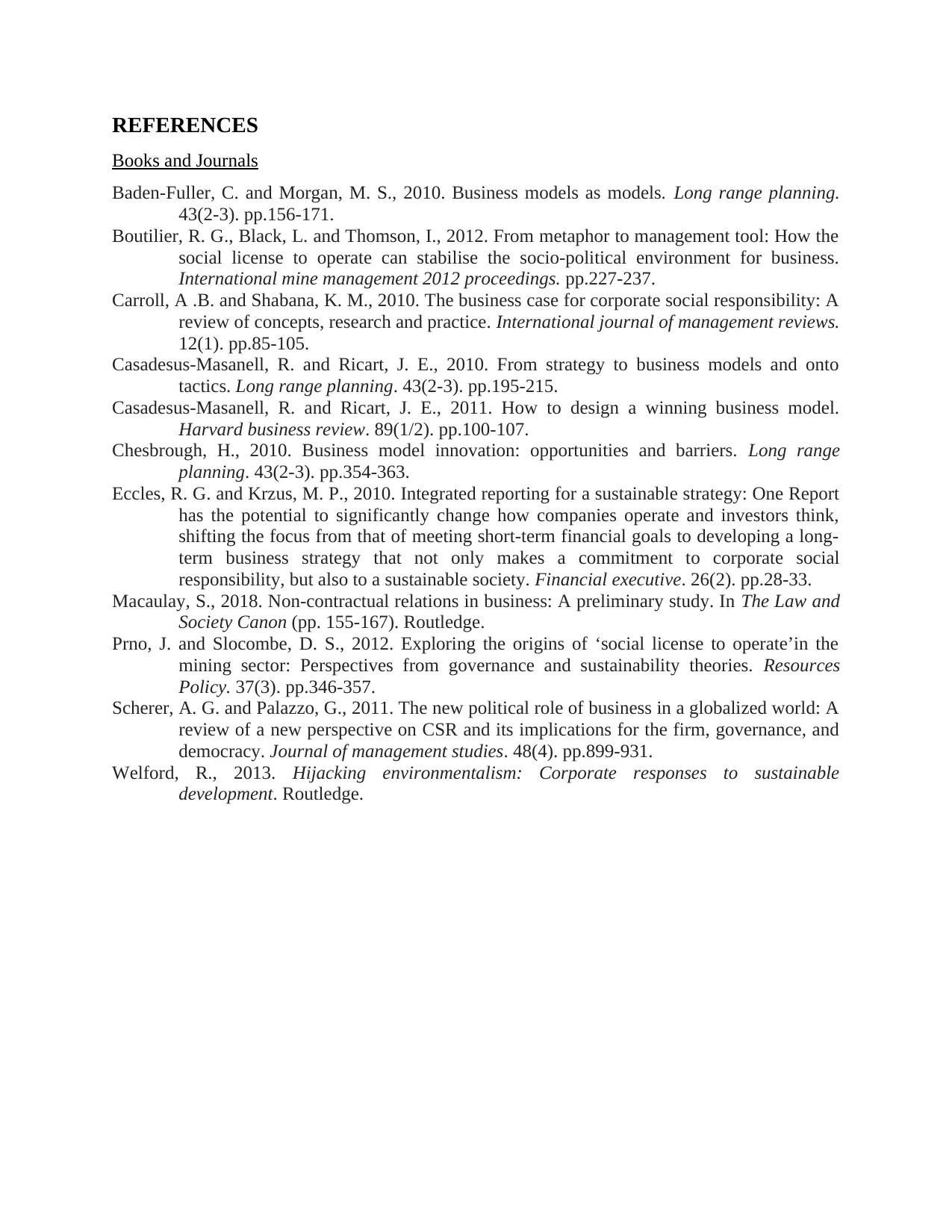
REFERENCES
Books and Journals
Baden-Fuller, C. and Morgan, M. S., 2010. Business models as models. Long range planning.
43(2-3). pp.156-171.
Boutilier, R. G., Black, L. and Thomson, I., 2012. From metaphor to management tool: How the
social license to operate can stabilise the socio-political environment for business.
International mine management 2012 proceedings. pp.227-237.
Carroll, A .B. and Shabana, K. M., 2010. The business case for corporate social responsibility: A
review of concepts, research and practice. International journal of management reviews.
12(1). pp.85-105.
Casadesus-Masanell, R. and Ricart, J. E., 2010. From strategy to business models and onto
tactics. Long range planning. 43(2-3). pp.195-215.
Casadesus-Masanell, R. and Ricart, J. E., 2011. How to design a winning business model.
Harvard business review. 89(1/2). pp.100-107.
Chesbrough, H., 2010. Business model innovation: opportunities and barriers. Long range
planning. 43(2-3). pp.354-363.
Eccles, R. G. and Krzus, M. P., 2010. Integrated reporting for a sustainable strategy: One Report
has the potential to significantly change how companies operate and investors think,
shifting the focus from that of meeting short-term financial goals to developing a long-
term business strategy that not only makes a commitment to corporate social
responsibility, but also to a sustainable society. Financial executive. 26(2). pp.28-33.
Macaulay, S., 2018. Non-contractual relations in business: A preliminary study. In The Law and
Society Canon (pp. 155-167). Routledge.
Prno, J. and Slocombe, D. S., 2012. Exploring the origins of ‘social license to operate’in the
mining sector: Perspectives from governance and sustainability theories. Resources
Policy. 37(3). pp.346-357.
Scherer, A. G. and Palazzo, G., 2011. The new political role of business in a globalized world: A
review of a new perspective on CSR and its implications for the firm, governance, and
democracy. Journal of management studies. 48(4). pp.899-931.
Welford, R., 2013. Hijacking environmentalism: Corporate responses to sustainable
development. Routledge.
Books and Journals
Baden-Fuller, C. and Morgan, M. S., 2010. Business models as models. Long range planning.
43(2-3). pp.156-171.
Boutilier, R. G., Black, L. and Thomson, I., 2012. From metaphor to management tool: How the
social license to operate can stabilise the socio-political environment for business.
International mine management 2012 proceedings. pp.227-237.
Carroll, A .B. and Shabana, K. M., 2010. The business case for corporate social responsibility: A
review of concepts, research and practice. International journal of management reviews.
12(1). pp.85-105.
Casadesus-Masanell, R. and Ricart, J. E., 2010. From strategy to business models and onto
tactics. Long range planning. 43(2-3). pp.195-215.
Casadesus-Masanell, R. and Ricart, J. E., 2011. How to design a winning business model.
Harvard business review. 89(1/2). pp.100-107.
Chesbrough, H., 2010. Business model innovation: opportunities and barriers. Long range
planning. 43(2-3). pp.354-363.
Eccles, R. G. and Krzus, M. P., 2010. Integrated reporting for a sustainable strategy: One Report
has the potential to significantly change how companies operate and investors think,
shifting the focus from that of meeting short-term financial goals to developing a long-
term business strategy that not only makes a commitment to corporate social
responsibility, but also to a sustainable society. Financial executive. 26(2). pp.28-33.
Macaulay, S., 2018. Non-contractual relations in business: A preliminary study. In The Law and
Society Canon (pp. 155-167). Routledge.
Prno, J. and Slocombe, D. S., 2012. Exploring the origins of ‘social license to operate’in the
mining sector: Perspectives from governance and sustainability theories. Resources
Policy. 37(3). pp.346-357.
Scherer, A. G. and Palazzo, G., 2011. The new political role of business in a globalized world: A
review of a new perspective on CSR and its implications for the firm, governance, and
democracy. Journal of management studies. 48(4). pp.899-931.
Welford, R., 2013. Hijacking environmentalism: Corporate responses to sustainable
development. Routledge.
⊘ This is a preview!⊘
Do you want full access?
Subscribe today to unlock all pages.

Trusted by 1+ million students worldwide
1 out of 13
Related Documents
Your All-in-One AI-Powered Toolkit for Academic Success.
+13062052269
info@desklib.com
Available 24*7 on WhatsApp / Email
![[object Object]](/_next/static/media/star-bottom.7253800d.svg)
Unlock your academic potential
Copyright © 2020–2025 A2Z Services. All Rights Reserved. Developed and managed by ZUCOL.





